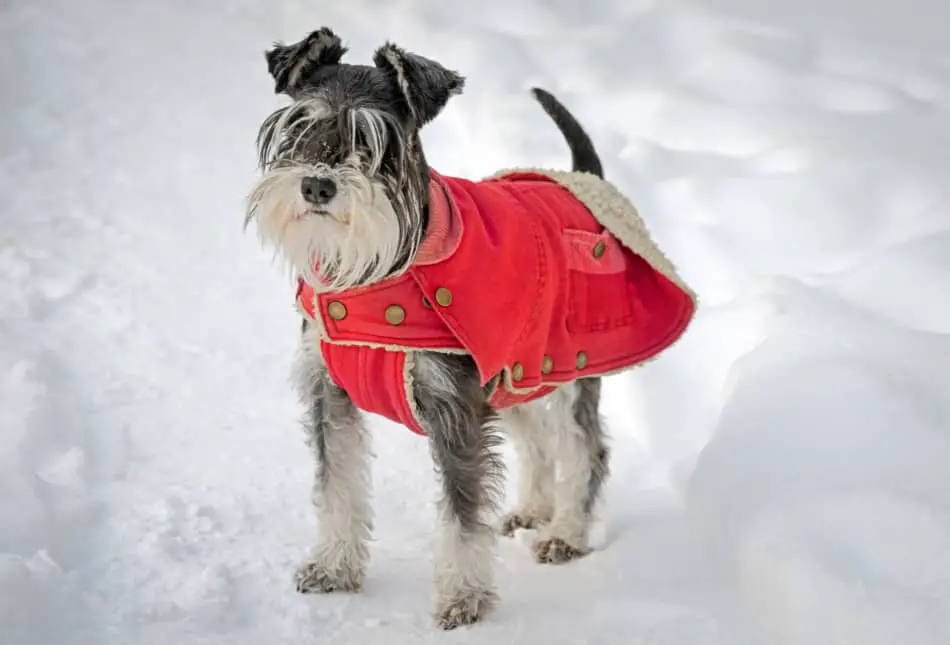We brought Livi home with us in the spring. The weather was nice and our three kids loved romping with her in our shady back yard. However, as we moved into winter and the snow piled up, the kids wanted to sled through our sloped forest of Shrub Oak trees. I suddenly wondered how well Livi would do in the cold and snow. I knew I needed to find out quickly.
Can Schnauzers Cope with the Cold and Snow? Yes, Schnauzers can handle temperatures as low as 32 degrees Fahrenheit, but do not tolerate extremely cold temperatures well. They have a double coat, were bred to work on cold German farms, and have inherited a good tolerance for low temperatures. However, they do need protection from frostbite and hypothermia.
Schnauzers do tend to tolerate cold temperatures quite well due to their genetics and double coat. That’s not to say, however, that they don’t need protection and some common-sense care from us. In addition, like us, they become acclimated to where they currently live and to whether or not they spend a lot of time outdoors.
Let’s talk about how well Schnauzers can really cope with the cold and snow.
Schnauzers’ Double Coat and Breeding Help Them Handle Cold Weather
Centuries ago, Schnauzers were bred to work on German farms and out in the fields. As guard dogs and ratters, they have historically spent a lot of time outdoors. As a result, all Schnauzer breeds (Miniature, Standard, and Giant) tend to benefit from their genetic inheritance when it comes to the cold.
They have a double-layered fur coating that serves as insulation. The outer layer that provides protection is wiry and tough while the inner layer is soft with a feel close to that of cotton.
Keep in mind that if you have clipped or shaved your Schnauzer’s coat, she is probably not protected by the wiry, outer coat anymore. Once shaved, it generally does not grow back. The undercoat, however, is still a soft, dense coat and provides protection…especially if you let it grow out…but your Schnauzer is not doubly protected.
If your Schnauzer’s undercoat has been hand-stripped (which is less and less common these days, at least in America), and the outercoat has never been entirely clipped or shaved, she will still have the wiry outercoat. The double coat needs to be well taken care of to prevent matting and knotting, especially if you take her out in the snow.
You should also trim the hair that is between pads of her paws to prevent snow from clumping and to provide better traction.
How Low Can You Go: What Temperature is Safe For Schnauzers?
Schnauzers can technically handle temperatures as low as 20 degrees Fahrenheit for short periods of time. However, you should start to monitor your Schnauzer when temperatures fall to 32 degrees Fahrenheit and ensure that he is handling it well.
Even though Schnauzers are known to be sturdy, hard-working dogs that can generally handle the cold, they are also susceptible to cold-weather dangers. Later in this article, I’ll cover the very serious situations of frostbite and hypothermia.
For now, just be reminded that your Schnauzer will let you know if he is getting uncomfortable in the cold temperature.
If temperatures are chilly, and you’ve been out for awhile, your pup may signal the outing is over by:
- Shivering
- Whining
- Slowing down or hesitating
- Seeking out shelter or warmth
- Holding up his paws or walking gingerly
Let’s consider ways you can prepare to go outside and then warm up safely afterwards.
Going Out and Coming In: Pre- and Post-Outing Checklist
Being prepared for the cold and snow can make winter months more of an adventure and less of a worry. Having cold-weather supplies and a plan for outings will streamline the entire season.

Preparing to Go Outside
- Choose the type of coat your Schnauzer might need based on the temperature and how long you plan to be in the cold or snow. There are several options that range from heavy vests to full-body overalls.
- Use booties on your Schnauzer’s paws.
- If your Schnauzer is not wearing booties, consider covering his paws with a balm, petroleum jelly, or even spray them with cooking spray (seriously). This will create a protective barrier between the paws and harsh winter elements.
- Consider walking your Schnauzer on the snow instead of on streets and sidewalks that might be covered with chemicals and salts.
- Go for Short Walks: You should shorten the amount of time you spend outside with your Schnauzer. If the weather is too cold for you, it is also too cold for him.
Warming Up After an Outing
- After being out in the cold, wash his paws and dry them to get rid of toxic products and salts. These elements can burn his paws and also lead to indigestion or poisoning if he licks them.
- When you get home from taking a walk, wipe his paws with a warm, wet towel to remove ice, residue, or salt. You could also dip his paws in a tub filled with lukewarm water, dry them, and lubricate them with a balm or petroleum jelly.
- If a bath is in order, a warm rinse would not only remove and melt any salt, snow, and ice, but would be a comfortable way to warm up. Use a blow dryer on very low temperature to dry his fur rather than letting him dry naturally.
- Consider offering a bowl of lukewarm water to gently increase his temperature from the inside out.
- Keep in mind that your Schnauzer will have higher caloric needs if he is walking or hiking outside regularly. Keep up with a nutritious diet.
- Make his favorite blanket available.
Additional Cold-Weather Safety Tips

Disorientation in the Snow
Schnauzers lose their sense of smell when snow is covering the ground. For this reason, you will want to keep your Schnauzer on a leash, or at least close to you if he is trained to stay by your side. You will also want to be sure he is wearing his ID tags.
Trail and Outdoor Safety
While this may sound like stating the obvious, it’s a good reminder. For your own safety, and that of your pup, be sure that your surroundings are safe. Watch for ice on your trails, and be sure to keep your Schnauzer away from lakes and ponds in case they are not frozen solid.
If your Schnauzer is romping in the park or neighborhood snow with kids, be sure that he doesn’t get in their way and visa versa. Sledding, in particular, can be dangerous with both dogs and kids involved. Snow days can be a lot of fun as long as everyone is safe.
For nighttime outings, be sure that both you and your Schnauzer are wearing reflective clothing. In addition, take a phone, flashlight, hand warmers, and other safety items in a small backpack.
Hazardous Cold-Weather Products and Plants
There are several common products and plants that are more available during cold winter months. Keep your Schnauzer away from poisonous products such as antifreeze, ice melt, and pesticides on recently treated lawn that can be absorbed by early snow.
In addition, make sure poisonous plants are either not in your home or are out of reach. Common winter plants such as Amaryllis, Christmas Cactus, Christmas trees, Mistletoe, Poinsettia, Holly, Lilies, Daffodils are all dangerous, and in some cases deadly, to your Schnauzer.
Age, Size, and Health Considerations
When you are taking your Schnauzer out, even if he is bundled up, remember that not all Schnauzers cope with the cold equally. Puppies, seniors, and smaller breeds such as a Miniature, or any Schnauzer with arthritis or other health problems, are all less tolerant of cold temperatures.
Cold, Even if Sheltered
Even if your Schnauzer is somewhat sheltered in cold temperatures, anything outside of a home could be too cold for them. Don’t leave them in a cold car when you run errands, and do not let them sleep in a doghouse over night.
Some Schnauzers May Not Like the Cold
Although Schnauzers have protective coats and were originally bred to withstand outdoor temperatures, keep in mind that they have become a much more domesticated breed over time. Most Schnauzers now spend much of their lives indoors and have not built up a first-hand tolerance for extreme temperatures.
In addition, while it is a normal practice to walk our pups even when it’s chilly, some Schnauzers many not ever grow to like or tolerate the cold. Just stay in tune with his body language and reaction.
Frostbite and Hypothermia: What You Need to Know
Even if you are very careful with your Schnauzer when outdoors in the cold temperatures, frostbite and hypothermia are both very real possibilities. These situations are very rare, but worth addressing.
Hypothermia is an extreme lowering of your pup’s body temperature due to exposure and wet or cold fur. Hypothermia is a grave situation, which, if not addressed immediately, can ultimately cause death.
Frostbite occurs when extremities are exposed to frigid cold. The skin and underlying tissue freezes and becomes damaged…sometimes beyond repair. Schnauzers are at risk of frostbite on their paws, ears, nose, scrotum, and tail.

Signs of Hypothermia
- Fur and skin are cold to the touch
- Overall body temperature is below 95 degrees Fahrenheit
- Gums and inner eyelids are noticeably blue, pale, or gray
- Vigorous, uncontrollable shivering that progresses to no shivering at all
- Dilated pupils
- Trouble walking
- Trouble breathing
- Decreased heart rate
- Sleepiness and lethargy
- Stupor, unconsciousness, or coma
Signs of Frostbite
- Affected area is cold or brittle to the touch
- Affected area is usually blue, pale, or gray
- Affected area is swollen and painful
- Affected area has ulcers or blisters
- Affected area is black and dead
Ways to Immediately Address Hypothermia and Frostbite
If you suspect that your Schnauzer is suffering from either hypothermia or frostbite, immediately take him to your veterinarian or to a veterinary hospital.

However, while you are transporting him to professional help, here are some things you can do to address his symptoms:
- Treat hypothermia first. Wrap him in dry, warm blankets or towels. You can also place a heating pad or water bottle wrapped in towels near him (not directly on him). If he is willing and able, let him drink lukewarm water.
- Treat frostbite next. Use a washcloth soaked in warm water (104 -108 degrees Fahrenheit, and comfortable to the touch) to gently warm the affected area. Do not use any type of dry heat like a heating pad or hair dryer on the affected area, and do not rub the affected area. Continue keeping him warm with blankets.
- Do not give him any human pain reliever. Both Ibuprofen and Acetaminophen are poisonous to dogs.
Winter is Fun When It’s Safe
Schnauzers are strong and hearty dogs, and many of them enjoy the cold and snow. While they are quite tolerant of low temperatures, arming yourself with information and cautions will ensure that all of your chilly outings and playdates are safe and successful.
And finally, from one pet parent to another, discover my all-time favorite resources designed to cover your every Schnauzer need. I’ve done the legwork for you so you can spend more time with the people and fur friends in your life.
A portion of all profit earned on this site is donated to Pet Partners
whose mission is to improve human health and
well-being through the human-animal bond.
They train and register pets to become therapy animals,
and have local chapters in many states.

